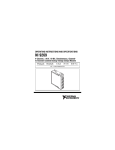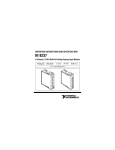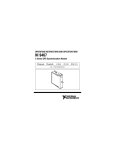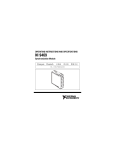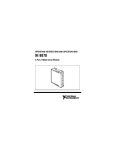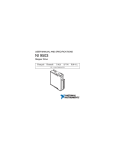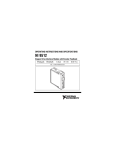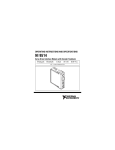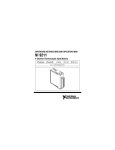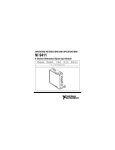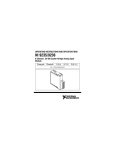Download NI 9501 Operating Instructions and Specifications
Transcript
OPERATING INSTRUCTIONS AND SPECIFICATIONS NI 9501 Stepper Drive Français Deutsch ni.com/manuals This document describes how to use the National Instruments 9501 module and includes specifications and pin assignments for the NI 9501. Visit ni.com/info and enter rdsoftwareversion to determine which software you need for the modules you are using. For information about installing, configuring, and programming the system, refer to the system documentation. Visit ni.com/info and enter cseriesdoc for information about C Series documentation. Note The safety guidelines and specifications in this document are specific to the NI 9501. The other components in the system may not meet the same safety ratings and specifications. Refer to the documentation for each component in the system to determine the safety ratings and specifications for the entire system. Safety Guidelines Operate the NI 9501 only as described in these operating instructions. This icon denotes that the component may be hot. Touching this component may result in bodily injury. Hot Surface NI 9501 Operating Instructions and Specifications 2 ni.com Safety Guidelines for Hazardous Locations The NI 9501 is suitable for use in Class I, Division 2, Groups A, B, C, D, T4 hazardous locations; Class I, Zone 2, AEx nA IIC T4, and Ex nA IIC T4 hazardous locations; and nonhazardous locations only. Follow these guidelines if you are installing the NI 9501 in a potentially explosive environment. Not following these guidelines may result in serious injury or death. Caution Do not disconnect I/O-side wires or connectors unless power has been switched off or the area is known to be nonhazardous. Do not remove modules unless power has been switched off or the area is known to be nonhazardous. Caution Substitution of components may impair suitability for Class I, Division 2. Caution For Division 2 and Zone 2 applications, install the system in an enclosure rated to at least IP 54 as defined by IEC 60529 and EN 60529. Caution © National Instruments Corp. 3 NI 9501 Operating Instructions and Specifications For Division 2 and Zone 2 applications, install a protection device between the input signal and the Vsup pin. The device must prevent the Vsup-to-channel voltage from exceeding 42 V if there is a transient overvoltage condition. Caution Special Conditions for Hazardous Locations Use in Europe This equipment has been evaluated as Ex nA IIC T4 equipment under DEMKO Certificate No. 07 ATEX 0626664X. Each module is marked II 3G and is suitable for use in Zone 2 hazardous locations, in ambient temperatures of –40 °C ≤ Ta ≤ 70 °C. If you are using the NI 9501 in Gas Group IIC hazardous locations, you must use the device in an NI chassis that has been evaluated as Ex nC IIC T4, EEx nC IIC T4, Ex nA IIC T4, or Ex nL IIC T4 equipment. Electromagnetic Compatibility Guidelines This product was tested and complies with the regulatory requirements and limits for electromagnetic compatibility (EMC) as stated in the product specifications. These requirements and limits are designed to provide reasonable protection against harmful interference when the product is operated in its intended operational electromagnetic environment. NI 9501 Operating Instructions and Specifications 4 ni.com This product is intended for use in industrial locations. As such, there is no guarantee that harmful interference will not occur in a particular installation, when the product is connected to a test object, or if the product is used in residential areas. To minimize the potential for the product to cause interference to radio and television reception or to experience unacceptable performance degradation, install and use this product in strict accordance with the instructions in the product documentation. Furthermore, any changes or modifications to the product not expressly approved by National Instruments could void your authority to operate it under your local regulatory rules. To ensure compliance with the applicable regulatory requirements, product installation requires either special considerations or user-installed, add-on devices. See the product installation instructions for further information. Caution The inputs/outputs of this product can be damaged if subjected to Electrostatic Discharge (ESD). To prevent damage, industry-standard ESD prevention measures must be employed during installation, maintenance, and operation. Caution © National Instruments Corp. 5 NI 9501 Operating Instructions and Specifications Special Guidelines for Marine Applications Some products are Lloyd’s Register (LR) Type Approved for marine (shipboard) applications. To verify Lloyd’s Register certification for a product, visit ni.com/certification and search for the LR certificate, or look for the Lloyd’s Register mark on the product label. In order to meet the EMC requirements for marine applications, install the product in a shielded enclosure with shielded and/or filtered power and input/output ports. In addition, take precautions when designing, selecting, and installing measurement probes and cables to ensure that the desired EMC performance is attained. Caution NI 9501 Operating Instructions and Specifications 6 ni.com NI 9501 Hardware Overview The NI 9501 is a stepper motor drive for use with 2-phase hybrid stepper motors in either bipolar or unipolar winding configuration. It uses an advanced PWM algorithm that reduces torque ripple, lowers emissions, minimizes power loss, and creates smoother motion during microstepping. National Instruments offers NEMA 17 and NEMA 23 stepper motors compatible with the NI 9501. Go to ni.com/motion/stepper for more information about NI stepper motors. Note The NI 9501 supports software-programmable full step, half step, and microstepping rates up to 256. When full-stepping, a resonance occurs at low speeds, generally defined as speeds between 50 and 150 RPM. This low-speed resonance causes vibration and reduces the motor torque. Using microstepping during this speed range provides much smoother motion and higher motor torque, effectively eliminating the low-speed resonance. At speeds over 150 RPM, the benefits of microstepping decrease and can eventually have an overall negative impact on performance by providing lower motor torque compared to © National Instruments Corp. 7 NI 9501 Operating Instructions and Specifications full-stepping. Refer to the NI 9501 topic in the LabVIEW Help, available by selecting Help»LabVIEW Help, for information about microstepping options. The NI 9501 also provides for phase current reduction after the motor stops moving for a certain amount of time using the Enable Current Reduction property in software. Unlike servo motors, the stepper motor coil remains fully energized when the motor is not moving. This allows for strong holding torque, but generates substantial heat in the motor. Many applications do not require maximum holding torque when the motor is at rest, which means that the motor is wasting power. The amount of current reduction and delay before current reduction becomes active is software-programmable. Refer to the NI 9501 topic in the LabVIEW Help, available by selecting Help»LabVIEW Help, for more information about current reduction. NI 9501 Operating Instructions and Specifications 8 ni.com NI 9501 FPGA Signals Isolation Phase A+ Step Dir H-Bridge Phase A– H-Bridge Phase B+ Phase B– CPLD* Status Vsup + COM – * CPLD = Complex Programmable Logic Device Figure 1. NI 9501 Block Diagram © National Instruments Corp. 9 NI 9501 Operating Instructions and Specifications Connecting the NI 9501 The NI 9501 has a 10-terminal detachable screw-terminal connector that provides connections for the stepper motor signals, a motor DC power supply, COM, and chassis ground. Refer to Figure 2 for the pin assignments. To ensure EMC compliance, special considerations are required for all cable connections. Refer to the Cable Requirements for EMC Compliance section. Caution Note You must use 2-wire ferrules to create a secure connection when connecting more than one wire to a single terminal on the NI 9501 screw terminal. Caution Do not turn on or plug in the motor DC power supply until the screw-terminal connector is fully inserted. NI 9501 Operating Instructions and Specifications 10 ni.com Phase A+ Phase A– Phase B+ Phase B– Reserved Reserved Reserved COM Vsup (Chassis Ground) 0 1 2 3 4 5 6 7 8 9 Figure 2. NI 9501 Connections © National Instruments Corp. 11 NI 9501 Operating Instructions and Specifications Motor Power Signals The Phase A± and Phase B± signals power the stepper motor. Figure 3 shows a typical bipolar stepper motor connection. Phase A+ Phase A– Phase B+ Phase B– Phase A+ Phase A– Phase B+ Phase B– Reserved Reserved Reserved COM Vsup 0 1 2 3 4 5 6 7 8 9 Figure 3. Typical Bipolar Stepper Motor (2-Phase Type) Connection Caution The stepper motor terminals on this drive are energized when the module is enabled. Do not connect wires to or disconnect wires from the NI 9501 when it is enabled. Use a multiconductor cable with an overall shield and conductors of 20 AWG or larger for the motor power cable. NI 9501 Operating Instructions and Specifications 12 ni.com The NI 9501 contains bipolar chopper drivers. Two-phase stepper motors come in 4-, 6-, and 8-wire variations. You must wire the stepper motors in a 4-wire configuration as shown in Figure 3. Caution Never connect unused stepper motor terminals to pin 9 (Chassis Ground) or to each other. When using a 6- or 8-wire stepper motor you must leave unused lead wires disconnected. Figure 4 shows a 6-wire and an 8-wire stepper motor. 6-wire 8-wire Figure 4. 6-Wire and 8-Wire Stepper Motors © National Instruments Corp. 13 NI 9501 Operating Instructions and Specifications A 4-wire motor is the same as a 6-wire motor except that the center taps (CT) are not brought out. To use a 6-wire motor in a 4-wire configuration you can isolate the center taps for a series (full coil) configuration. Series configurations produce the most torque per amp but have the disadvantage of poorer high-speed performance. Phase A+ NC* Phase A– Phase B+ NC* Phase B– Phase A+ Phase A– Phase B+ Phase B– Reserved Reserved Reserved COM Vsup 0 1 2 3 4 5 6 7 8 9 *NC = Not Connected Figure 5. 6-Wire Series Stepper Motor Connection (Higher Torque, Lower Speed) NI 9501 Operating Instructions and Specifications 14 ni.com You can obtain improved high-speed performance with a 6-wire motor by using a half-coil configuration shown in Figure 6. This configuration sacrifices low-speed torque for better high-speed performance. With this configuration, it is typically not possible to produce the rated torque of the motor without the risk of the motor overheating because only half of the windings are used. Phase A+ Phase A– NC* Phase B+ Phase B– NC* Phase A+ Phase A– Phase B+ Phase B– Reserved Reserved Reserved COM Vsup 0 1 2 3 4 5 6 7 8 9 *NC = Not Connected Figure 6. 6-Wire Half-Coil Stepper Motor Connection (Higher Speed, Lower Torque) © National Instruments Corp. 15 NI 9501 Operating Instructions and Specifications For maximum flexibility, you can connect 8-wire stepper motors in series, parallel, or half-coil configurations. Connecting the windings in a series configuration, as shown in Figure 7, produces the most torque per amp but has the disadvantage of higher inductance and poorer high-speed performance. Phase A+ Phase A– Phase B+ Phase B– Phase A+ Phase A– Phase B+ Phase B– Reserved Reserved Reserved COM Vsup 0 1 2 3 4 5 6 7 8 9 Figure 7. 8-Wire Series Stepper Motor Connection (Higher Torque, Lower Speed) NI 9501 Operating Instructions and Specifications 16 ni.com Notice that an 8-wire motor wired in a series configuration is virtually identical to a 6-wire motor and typically has the same high torque but low-speed characteristics. Alternatively, you can connect 8-wire stepper motors in a parallel configuration as shown in Figure 8. This configuration produces better high-speed performance but requires more current to produce rated torque. Phase A+ Phase A– Phase B+ Phase B– Phase A+ Phase A– Phase B+ Phase B– Reserved Reserved Reserved COM Vsup 0 1 2 3 4 5 6 7 8 9 Figure 8. 8-Wire Parallel Stepper Motor Connection (Higher Speed, Lower Torque) © National Instruments Corp. 17 NI 9501 Operating Instructions and Specifications Finally, you can connect 8-wire stepper motors in a half-coil configuration as shown in Figure 9. The half-coil configuration sacrifices low-speed torque for better high-speed performance. With this configuration, it is typically not possible to produce the rated torque of the motor without the risk of the motor overheating because only half of the windings are used. Phase A+ Phase A– NC NC Phase B+ Phase B– NC NC Phase A+ Phase A– Phase B+ Phase B– Reserved Reserved Reserved COM Vsup 0 1 2 3 4 5 6 7 8 9 *NC = Not Connected Figure 9. 8-Wire Half-Coil Stepper Motor Connection NI 9501 Operating Instructions and Specifications 18 ni.com Wiring for High Vibration Applications If an application is subject to high vibration, National Instruments recommends that you use ferrules to terminate wires to the detachable screw-terminal connector. Refer to Figure 10 for an illustration of using ferrules. Ferrule Figure 10. 10-Terminal Detachable Screw-Terminal Connector with Ferrule © National Instruments Corp. 19 NI 9501 Operating Instructions and Specifications LED Indicators The NI 9501 has four LEDs to display status information. 1 1 Enabled (green) 2 Vsup (Motor Power) (green) 2 3 4 3 User (yellow) 4 Fault (red) Enabled The Enabled LED (green) illuminates when the drive is enabled and the output power stage is active, and is flashing when the drive is disabled and the output power stage is inactive. Refer to the NI 9501 topic in the LabVIEW Help, available by selecting Help»LabVIEW Help, for information about enabling the drive. NI 9501 Operating Instructions and Specifications 20 ni.com Vsup The Vsup LED (green) illuminates when the motor DC power supply is properly connected. User You can define the User LED (yellow) to meet the needs of your application. Use the User LED I/O node to turn this LED on and off. Refer to the NI 9501 topic in the LabVIEW Help, available by selecting Help»LabVIEW Help, for information about the NI 9501 User LED I/O node. Fault If the Fault LED is lit, determine the cause of the fault and correct it before enabling the drive. Caution The Fault LED (red) illuminates when a fault occurs. A fault disables the drive. Causes for fault are the following: Vsup greater than 40 V will result in damage to the NI 9501. Caution • Vsup overvoltage • Vsup undervoltage © National Instruments Corp. 21 NI 9501 Operating Instructions and Specifications • Motor terminal (Phase A± or Phase B±) short to Vsup • Motor terminal (Phase A± or Phase B±) short to COM Hot-Swap Behavior The NI 9501 is always disabled when it is first inserted in the chassis, regardless of whether Vsup is present or not. You can enable the drive using the Enable Drive method in software. Refer to the NI 9501 topic in the LabVIEW Help, available by selecting Help»LabVIEW Help, for more information about enabling the drive. When the NI 9501 is removed from the chassis while it is enabled, the power to the motor is removed and the motor decelerates to a stop based on its own friction. Sleep Mode This module supports a low-power sleep mode. Support for sleep mode at the system level depends on the chassis that the module is plugged into. Refer to the chassis manual for information about support for sleep mode. If the chassis supports sleep mode, refer to the software help for information about enabling sleep mode. NI 9501 Operating Instructions and Specifications 22 ni.com Visit ni.com/info and enter cseriesdoc for information about C Series documentation. Typically, when a system is in sleep mode, you cannot communicate with the modules. In sleep mode, the system consumes minimal power and may dissipate less heat than it does in normal mode. Refer to the Specifications section for more information about power consumption and thermal dissipation. Cable Requirements for EMC Compliance Select and install cables for the NI 9501 in accordance with the following requirements: • Do not tie the motor case to the NI 9501 chassis ground. • The motor power cable must be a multiconductor cable with an overall shield. • Tie the motor cable shield to COM at the module side only. Do not tie the motor cable shield to the motor case. © National Instruments Corp. 23 NI 9501 Operating Instructions and Specifications • Install a clamp-on ferrite bead onto both the motor cable and Vsup cable, as shown in Figure 11. Power to the module must be off when adding ferrites. Note The wire connecting the motor cable shield to COM bypasses the ferrite as shown in Figure 11. NI 9501 Phase A+ Phase A– Phase B+ Phase B– Motor Shield Motor DC Power Supply Ferrites COM Vsup Figure 11. NI 9501 Cable Connection • Clamp-on ferrites must be connected to the motor cable and Vsup cable as close to the module as possible with a full turn as shown in Figure 12. Placing the ferrite elsewhere on the cable noticeably impairs its effectiveness. NI 9501 Operating Instructions and Specifications 24 ni.com Figure 12. Installing a Ferrite • Determine the clamp-on ferrite beads to install based on twice the motor cable and Vsup cable diameter. Order the appropriate ferrite beads from NI. NI Part Number Aperture Size mm (inches) 781233-01 7.0 (0.275) 781233-02 10.2 (0.402) 777297-01 13.4 (0.528) © National Instruments Corp. 25 NI 9501 Operating Instructions and Specifications Specifications The following specifications are typical for the temperature range –40 to 70 °C unless otherwise noted. All voltages are relative to COM unless otherwise noted. Input/Output Characteristics Motor DC power supply (Vsup) ....... +9 to +30 VDC Max step pulse rate ........................... 5 MHz Minimum phase inductance.............. 1 mH Type .................................................. Bipolar chopper Chopping frequency.......................... 20 kHz Current per phase.............................. 3 A RMS (4.24 A peak) Current reduction .............................. 0%, 25%, or 50% Microstepping selections .................. ×2, 4, 8, 16, 32, 64, 128, 256 (software-selectable) Vsup capacitance .............................. 750 µF MTBF ............................................... Contact NI for Bellcore MTBF specifications. NI 9501 Operating Instructions and Specifications 26 ni.com Drive Protection Undervoltage..................................... <6 V Caution Vsup greater than 40 V will result in damage to the module. Overvoltage....................................... >32 V Motor terminal (Phase A±/Phase B±) short to ground.................................. Yes Motor terminal (Phase A±/Phase B±) short to Vsup..................................... Yes Power Requirements Power consumption from chassis Active mode ............................... 500 mW max Sleep mode ................................. 2.5 mW max Thermal dissipation (at 70 °C) Active mode ............................... 1.5 W max Sleep mode ................................. 2.5 mW max © National Instruments Corp. 27 NI 9501 Operating Instructions and Specifications Physical Characteristics If you need to clean the module, wipe it with a dry towel. Note For two-dimensional drawings and three-dimensional models of the C Series module and connectors, visit ni.com/dimensions and search by module number. Screw terminal wiring....................... 12 to 24 AWG copper conductor wire with 10 mm (0.39 in.) of insulation stripped from the end Torque for screw terminals ............... 0.5 to 0.6 N · m (4.4 to 5.3 lb · in.) Ferrules ............................................. 0.25 mm2 to 2.5 mm2 Weight............................................... 144 g (5.1 oz) NI 9501 Operating Instructions and Specifications 28 ni.com Safety Safety Voltages Connect only voltages that are within the following limits. Channel-to-COM .............................. 0 to +30 VDC max, Measurement Category I Isolation Channel-to-channel .................... None Channel-to-earth ground Continuous ........................... 60 VDC, Measurement Category I Withstand ............................. 1000 Vrms, verified by a 5 s dielectric withstand test Measurement Category I is for measurements performed on circuits not directly connected to the electrical distribution system referred to as MAINS voltage. MAINS is a hazardous live electrical supply system that powers equipment. This category is for measurements of voltages from specially protected secondary circuits. Such voltage measurements include signal levels, special equipment, limited-energy parts of equipment, circuits powered by regulated low-voltage sources, and electronics. © National Instruments Corp. 29 NI 9501 Operating Instructions and Specifications Do not connect the NI 9501 to signals or use for measurements within Measurement Categories II, III, or IV. Caution Hazardous Locations U.S. (UL) .......................................... Class I, Division 2, Groups A, B, C, D, T4; Class I, Zone 2, AEx nA IIC T4 Canada (C-UL) ................................. Class I, Division 2, Groups A, B, C, D, T4; Class I, Zone 2, Ex nA IIC T4 Europe (DEMKO)............................. Ex nA IIC T4 Power Supply Requirements Caution You must use a UL Listed ITE power supply marked LPS with the NI 9501. NI 9501 Operating Instructions and Specifications 30 ni.com Safety Standards The NI 9501 is designed to meet the requirements of the following standards of safety for electrical equipment for measurement, control, and laboratory use: • IEC 61010-1, EN 61010-1 • UL 61010-1, CSA 61010-1 Note For UL and other safety certifications, refer to the product label or the Online Product Certification section. Electromagnetic Compatibility This product meets the requirements of the following EMC standards for electrical equipment for measurement, control, and laboratory use: • EN 61326-1 (IEC 61326-1): Class A emissions; Industrial immunity • EN 55011 (CISPR 11): Group 1, Class A emissions • AS/NZS CISPR 11: Group 1, Class A emissions • FCC 47 CFR Part 15B: Class A emissions • ICES-001: Class A emissions © National Instruments Corp. 31 NI 9501 Operating Instructions and Specifications Note For the standards applied to assess the EMC of this product, refer to the Online Product Certification section. Note For EMC compliance, operate this device with shielded cabling. CE Compliance This product meets the essential requirements of applicable European directives as follows: • 2006/95/EC; Low-Voltage Directive (safety) • 2004/108/EC; Electromagnetic Compatibility Directive (EMC) Online Product Certification Refer to the product Declaration of Conformity (DoC) for additional regulatory compliance information. To obtain product certifications and the DoC for this product, visit ni.com/ certification, search by module number or product line, and click the appropriate link in the Certification column. NI 9501 Operating Instructions and Specifications 32 ni.com Shock and Vibration To meet these specifications, you must panel mount the system and affix ferrules to the end of the screw terminal wires. Operating vibration Random (IEC 60068-2-64)......... 5 grms, 10 to 500 Hz Sinusoidal (IEC 60068-2-6) ....... 5 g, 10 to 500 Hz Operating shock (IEC 60068-2-27).............................. 30 g, 11 ms half sine, 50 g, 3 ms half sine, 18 shocks at 6 orientations Environmental National Instruments C Series modules are intended for indoor use only, but may be used outdoors if installed in a suitable enclosure. Refer to the manual for the chassis you are using for more information about meeting these specifications. Operating temperature (IEC 60068-2-1, IEC 60068-2-2) ..... –40 to 70 °C Storage temperature (IEC 60068-2-1, IEC 60068-2-2) ..... –40 to 85 °C © National Instruments Corp. 33 NI 9501 Operating Instructions and Specifications Ingress protection.............................. IP 40 Operating humidity (IEC 60068-2-56).............................. 10 to 90% RH, noncondensing Storage humidity (IEC 60068-2-56).............................. 5 to 95% RH, noncondensing Maximum altitude............................. 2,000 m Pollution Degree (IEC 60664) .......... 2 Environmental Management NI is committed to designing and manufacturing products in an environmentally responsible manner. NI recognizes that eliminating certain hazardous substances from our products is beneficial to the environment and to NI customers. For additional environmental information, refer to the NI and the Environment Web page at ni.com/environment. This page contains the environmental regulations and directives with which NI complies, as well as other environmental information not included in this document. NI 9501 Operating Instructions and Specifications 34 ni.com Waste Electrical and Electronic Equipment (WEEE) EU Customers At the end of the product life cycle, all products must be sent to a WEEE recycling center. For more information about WEEE recycling centers, National Instruments WEEE initiatives, and compliance with WEEE Directive 2002/96/EC on Waste and Electronic Equipment, visit ni.com/environment/ weee. ⬉ᄤֵᙃѻક∵ᶧࠊㅵ⧚ࡲ⊩ ˄Ё RoHS˅ Ёᅶ᠋ National Instruments ヺড়Ё⬉ᄤֵᙃ ѻકЁ䰤ࠊՓ⫼ᶤѯ᳝ᆇ⠽䋼ᣛҸ (RoHS)DŽ݇Ѣ National Instruments Ё RoHS ড়㾘ᗻֵᙃˈ䇋ⱏᔩ ni.com/environment/rohs_chinaDŽ (For information about China RoHS compliance, go to ni.com/ environment/rohs_china.) © National Instruments Corp. 35 NI 9501 Operating Instructions and Specifications Where to Go for Support The National Instruments Web site is your complete resource for technical support. At ni.com/support you have access to everything from troubleshooting and application development self-help resources to email and phone assistance from NI Application Engineers. National Instruments corporate headquarters is located at 11500 North Mopac Expressway, Austin, Texas, 78759-3504. National Instruments also has offices located around the world to help address your support needs. For telephone support in the United States, create your service request at ni.com/support and follow the calling instructions or dial 512 795 8248. For telephone support outside the United States, contact your local branch office: Australia 1800 300 800, Austria 43 662 457990-0, Belgium 32 (0) 2 757 0020, Brazil 55 11 3262 3599, Canada 800 433 3488, China 86 21 5050 9800, Czech Republic 420 224 235 774, Denmark 45 45 76 26 00, Finland 358 (0) 9 725 72511, France 01 57 66 24 24, Germany 49 89 7413130, India 91 80 41190000, Israel 972 3 6393737, Italy 39 02 41309277, Japan 0120-527196, Korea 82 02 3451 3400, Lebanon 961 (0) 1 33 28 28, NI 9501 Operating Instructions and Specifications 36 ni.com Malaysia 1800 887710, Mexico 01 800 010 0793, Netherlands 31 (0) 348 433 466, New Zealand 0800 553 322, Norway 47 (0) 66 90 76 60, Poland 48 22 328 90 10, Portugal 351 210 311 210, Russia 7 495 783 6851, Singapore 1800 226 5886, Slovenia 386 3 425 42 00, South Africa 27 0 11 805 8197, Spain 34 91 640 0085, Sweden 46 (0) 8 587 895 00, Switzerland 41 56 2005151, Taiwan 886 02 2377 2222, Thailand 662 278 6777, Turkey 90 212 279 3031, United Kingdom 44 (0) 1635 523545 © National Instruments Corp. 37 NI 9501 Operating Instructions and Specifications LabVIEW, National Instruments, NI, ni.com, the National Instruments corporate logo, and the Eagle logo are trademarks of National Instruments Corporation. Refer to the Trademark Information at ni.com/trademarks for other National Instruments trademarks. Other product and company names mentioned herein are trademarks or trade names of their respective companies. For patents covering National Instruments products/technology, refer to the appropriate location: Help»Patents in your software, the patents.txt file on your media, or the National Instruments Patent Notice at ni.com/patents. © 2010 National Instruments Corp. All rights reserved. 375479C-01 Dec10






































